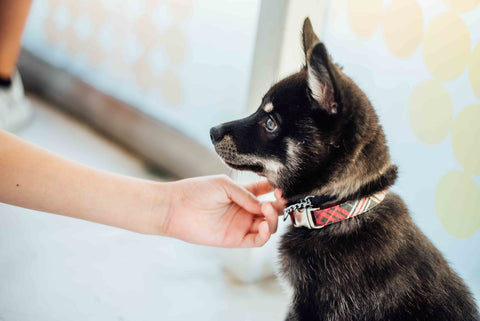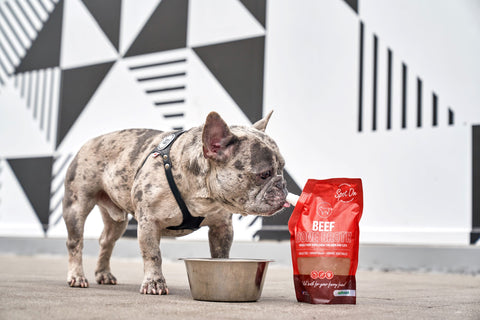We understand that raising a well-behaved dog can be challenging with a busy lifestyle. This is why Healthy Spot is proud to pawtner with Tully’s Training for all of your dog training needs. Tully’s Training offers a refreshing approach to dog training based on the science of learning and utilizes positive reinforcement techniques to help your pup achieve their best behavior.
If you have a pup that might need some help with certain behaviors, check out these 10 tips from Tully’s Training! Plus if you want to get special training experiences, you can sign up for Tully's Training group classes here!

1- Behavior Reinforcement
Any behavior that is reinforced will be repeated! Reinforcement can be food, toys, attention, verbal interaction or any other stimulus that your dog enjoys. This means that even behavior we DON’T like can be reinforced inadvertently, so it’s important to be aware of your interactions with your dog. Pups pick up on tendencies easier than you’d think.
2- Daily Mental Exercise
Your dog needs daily mental exercise just as much as physical exercise! Scent games, agility, puzzle toys and training sessions are simple ways to get your dog more mental exercise. Especially as puppies, it’s important to form habits to use their growing brains!
3- Habit Changes
If your dog has a habit that you’d like to change, first start by assessing the environment. Does your dog rummage through the garbage? Put the garbage somewhere she can’t get to it. Does he bark at the front window? Use a gate or pen to block his access to the window. Then you can work on the behavior you PREFER instead!
4- Nonverbal Communication
Learn to speak dog! Dogs primarily communicate nonverbally - using body language! Some signs are obvious but others are much more subtle. Pro tip: leave your dog at home and visit the dog park without him. Watch the other dogs interact (take videos if the other owners don’t mind). It’s amazing what you’ll see when you’re not focused on your own dog! We tend to get stuck in our ways, but opening your eyes to other possibilities is an easy way to learn new tricks.
5- Teaching Them Their Name
Teach your dog their name - when your dog is not looking at you, call their name (only once!), wait for them to look at you, then treat! This behavior, if taught properly, can be a lifesaver if you need your dog’s attention.
6- Puppies Teething
Puppies use their mouth! A lot! It’s a normal and important part of their development; however, it’s important to teach them that biting people is not socially acceptable. We suggest the “Three Strikes You’re Out” plan. Any time you feel puppy teeth on you:
- Strike One: Move your body away. Pick up your arms or move your legs. Ignore your puppy and wait a few seconds. If your puppy calms down, resume your game!
- Strike Two: Stand up. Ignore your puppy and wait a few seconds. If your puppy calms down, resume your game!
- Strike Three: Leave the room. The game is over.
This teaches your puppy that the fun can only happen when they keep their teeth to themselves!
7- Adopted Dogs
If you adopt a dog from a shelter or rescue, keep in mind that your home may not be their first home. It’s a good idea to give them some time to adjust before expecting them to acclimate to your schedule and household. Give them a quiet space to relax if they are feeling overwhelmed! Most dogs take a couple weeks to a couple months to learn to trust their new environment.
8- Dogs Showing Stress
Give your dog a choice! If your dog is showing signs of stress, allow them to leave the situation or give them more space. They shouldn’t have to tackle stressful situations if they don’t need to. These situations can arise from becoming nervous around other dogs or new environments. Acclimate them to these new habits by taking it slower. If your pup isn’t as social as you’d like, have them socialize with one pup before you put them in a room of 10!
9- Making Your Walks Interactive
When going on walks, every so often you can call your dog’s name, wait for them to look up at you, then give them a treat. Teaching them to “check in” gives them something to do and reduces the risk of unwanted behaviors such as barking at other dogs or pulling on their leash. You can also take pauses for them to sit so they get the added bonus of training time, and to let them cool down if they get overheated easily. Another easy tip is to PUT THAT CELL PHONE AWAY! Let your pup know this is their time, and you’re focused on them. It will be more enjoyable for both of you.
10- Make Training Fun!
Training your dog should be FUN! Make sure to teach your dog some silly tricks or games, as well as their basic behaviors. It’s good exercise and it’s great for your relationship. One easy trick we like: sit on the floor with your legs extended in front of you. Lure your dog over your legs with a treat. As it gets easier, stack your legs on top of each other so your dog has to jump! While you’ll feel proud to show off their new skills, they’ll be eager to present them!
We’re proud to partner with such an amazing organization like Tully’s Training. In addition to Tully’s Puppy Preschool where puppies under 6 months old gain social skills among other unvaccinated puppies, Tully’s Training hosts 6 week group classes for dogs in their puppy months and adult years in our Healthy Spot locations. Group classes are a great way for your pup to meet some new fur-iends and establish new training methods! Click here for more info. The next round of classes start September 29th!



Comments (0)
There are no comments for this article. Be the first one to leave a message!